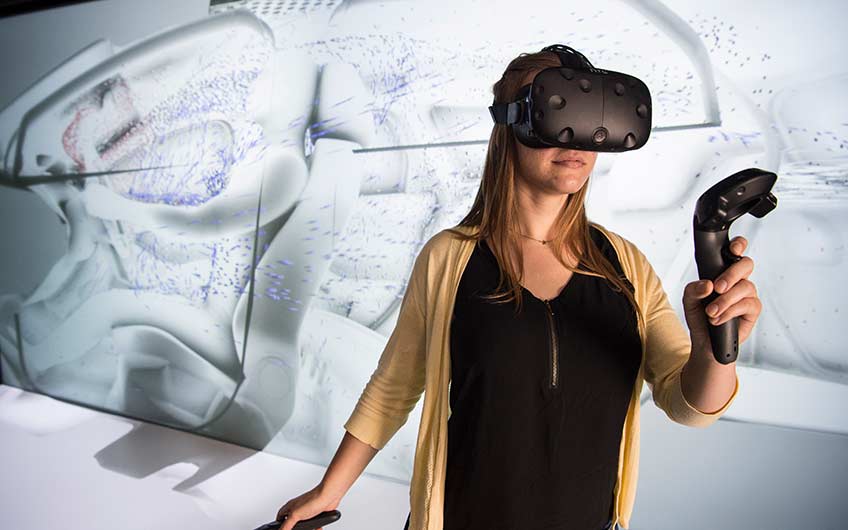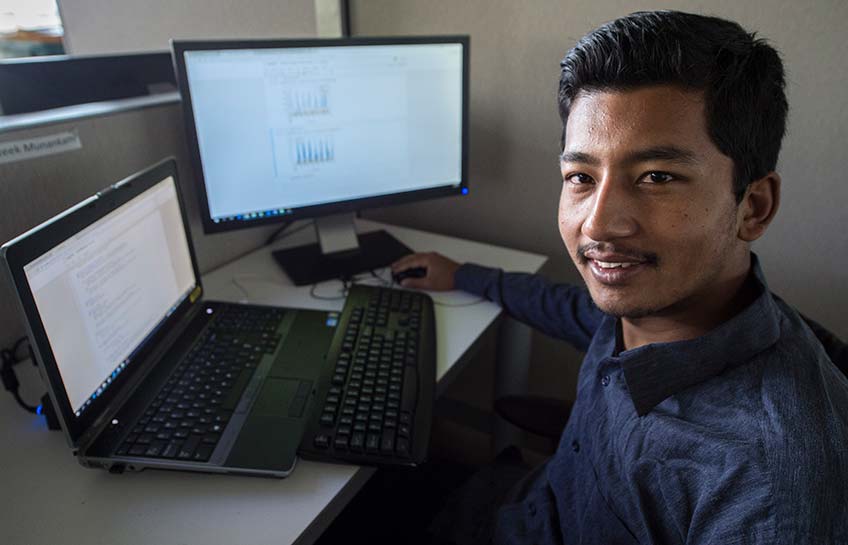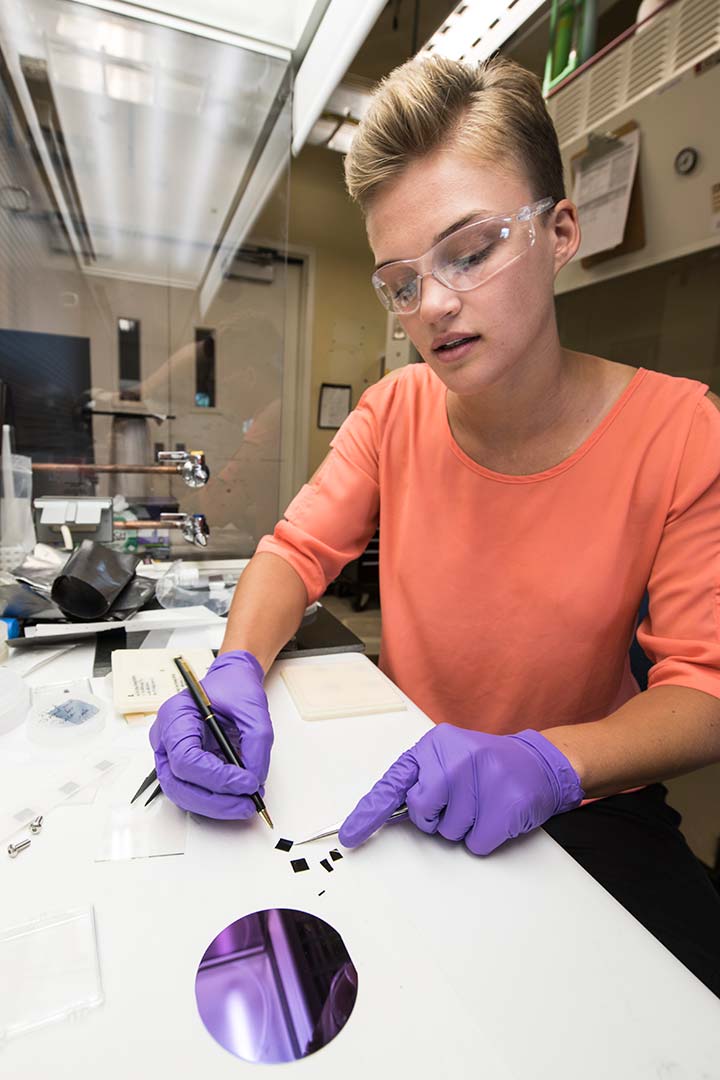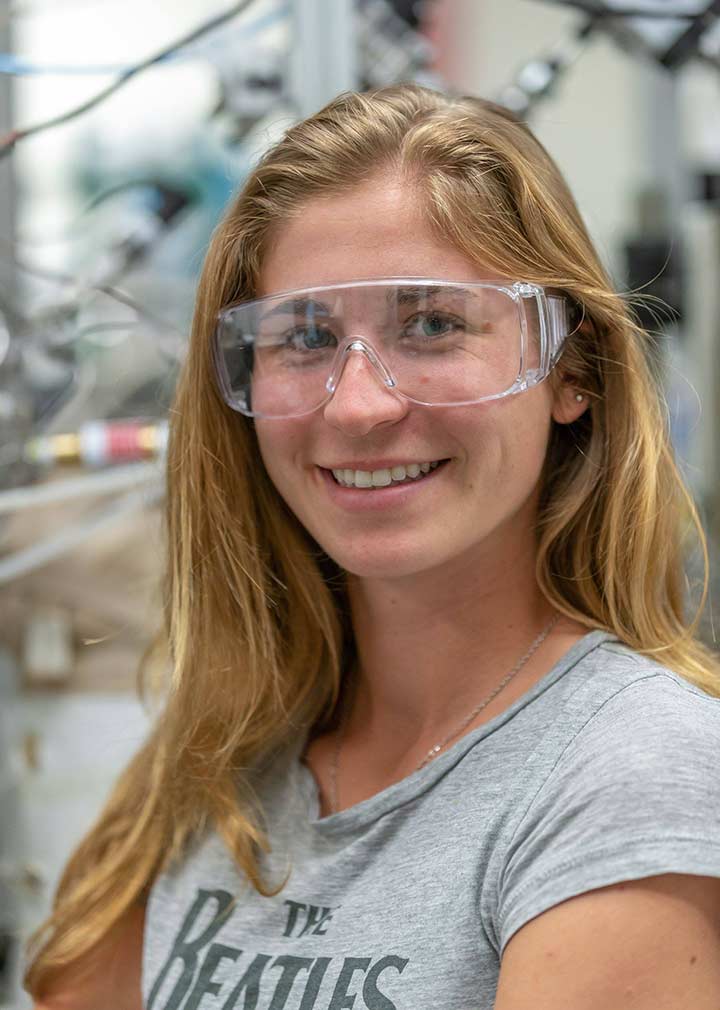NREL Interns Energize the Laboratory

Alyssa Boll testing a sample application on the HTC Vive at the Energy Systems Integration Facility (ESIF) Insight Center. Photo by Dennis Schroeder, NREL
Each year, students trade their backpacks for thinking caps as they make their way to the National Renewable Energy Laboratory (NREL) from all over the world to explore their passions in renewable energy. Highly motivated students and recent graduates are given the opportunity to turn their knowledge into action working alongside world-renowned researchers and cutting-edge technologies from day one.
"What at first was this intimidating and difficult challenge became one of the most exhilarating successes," said Alyssa Boll, a participant in the Energy Department's Science Undergraduate Laboratory Internships (SULI) program at NREL. On her first day as a part of the Data Analysis and Visualization (DAV) group, a box was waiting for Boll to open containing an HTC Vive, a virtual reality (VR) headset that would soon be her puzzle to solve with guidance from her mentor Nicholas Brunhart-Lupo.
As a rising senior at Colorado School of Mines studying electrical engineering, Boll came to NREL eager to bring her knowledge of software and hardware into the world of VR. "We weren't sure how far we'd get by the end of the summer, but to see the results come to fruition and know the technology will be put to use after I'm gone, feels like I made the greatest possible impact," Boll said. The 3D OpenGL graphic simulations Boll successfully transmitted over to the Vive allows researchers to analyze data in VR from the comfort of their own desks while giving the DAV group the opportunity to evaluate the impact of different levels of VR immersion on scientific visualization effectiveness.
Additionally, Boll exceeded her day-to-day work integrating software by offering to give some of the tours through the Insight Center. "It was so rewarding to see people's reactions to the technology especially when it is applied to the renewable research here on campus. They can see the potential," Boll said.
The potential Boll speaks of is ubiquitous across the intern experience through limitless opportunity to be at the forefront of transforming energy.
Of the 58 SULIs, 77 Research Participant Program (RPP) undergraduate interns, 96 RPP graduate interns, and four community college interns, coming to work in Golden, Colorado is exciting, but for Prateek Munankarmi, being in Colorado felt like he was home.

Prateek Munankarmi performs simulation modeling and data analysis on the interactions between energy system resources. Photo by Dennis Schroeder, NREL
Munankarmi, a Research Participant Program Intern (RPP), grew up in Nepal surrounded by snow-covered mountains that ignited in him an appetite for adventure. After deciding to pursue his master's degree in Electrical Engineering, Munankarmi left Nepal to come to South Dakota State University. Initially, he was shocked at how flat America was – that is, until he came to NREL.
Munankarmi joined the Power Systems Engineering Center to research how different resources in the home interact with the grid. By designing test-case scenarios on the IEEE-8500 test system, Munankarmi investigated the interactions of resources such as photovoltaics (PV), energy storage, and the home energy management system. Munankarmi's keen understanding of grid integration in the home materialized during his first job after his undergraduate degree as an electrical maintenance engineer on a hydropower station in Nepal. "Getting the technical experience working in hydropower in Nepal helped me understand the grid better, which has helped me be a better engineer here at NREL."
Munankarmi attributes his interest in renewable energy to growing up in a renewable energy-driven Nepal where he also discovered his love of getting outside, especially the mountains. While at NREL, Munankarmi and some his fellow interns planned a camping trip to Sky Pond in Rocky Mountain National Park. After the weekend was over, Munankarmi said, "I looked at a map on the way home and instantly saw how we only covered a small portion of it. Now, I just want to go back and keep discovering."
The thirst for discovery gave Munankarmi the opportunity to get the most out of his internship experience. Munankarmi said, "One of the best parts about my internship and first job in America has been how much I've been able to learn. I know that in continuing to work in renewables, NREL will have helped me understand the importance of always learning."

Of those dedicated to transforming renewable energy is Amanda Matheson, a SULI participant and recent graduate from the Colorado School of Mines with a degree in engineering physics. "I want to help make solar cells more efficient," said Matheson, who has been eager to fulfill her desire since she first learned how it would be possible. In school, Matheson investigated how to pattern areas of silicon substrates with the hope of one day getting to etch v-shaped grooves into the silicon to make solar cells more efficient. In her time at NREL she has been able to do just that. With the guidance of what Matheson describes as her "inspiring team of female role models" – Emily Makoutz, Emily Warren, and Adele Tamboli – Matheson designed and built a laser interference lithography system to pattern large areas (about 4 square centimeters) of silicon substrates.
For Matheson, her team and the NREL community at large had a substantial influence on her research. "Everyone at NREL is inspired by the mission. People want to exchange ideas and work together to solve challenges," she said. "It's impressive to see the women I work with have such a powerful presence in their field. It shows me that it's possible for me to excel as well."
Matheson is confident that her work will help pave the way for cost reductions in the development of multi-junction solar cells, and she will continue her journey by pursuing her Ph.D. in materials science from University of California, Santa Barbara, in the fall.
Budding Futures

On a piece of scratch paper in a freshman-year chemical engineering class, Kathleen Brown wrote down a goal she would one day hope to achieve with her degree, that she would find a way to create a type of biodegradable plastic. After completing her degree in chemical engineering from the University of Colorado-Boulder, Brown arrived at NREL as an RPP Intern ready to work towards making her dreams a reality. Over the summer, Brown worked on two separate tasks where she would heat up biomass or a model compound to a certain temperature, run the vapors over a catalyst bed, and analyze the final product. This research allows Brown to identify system parameters like temperatures and pressures as well as a catalyst to help produce new cost-effective jet fuel and other petroleum-based fuels.
Brown relates her research to that of the makeup of a tree. "Whole vapors involves the feedstock as whole biomass, it's like a pine tree being ground up or shredded, so for this task I test the whole tree all at once," said Brown. "For model compounds, I test one compound that represents a part of the whole biomass. First, I would test only how the leaves behave in the presence of a certain catalyst, then only the bark, then only the wood."
As her research continues to develop, Brown hopes to achieve her goals once written on scratch paper while uncovering new ambitions like one day replacing jet fuel. "I want to continue to create a positive impact on the earth truly making the responsibility of my degree worthwhile," Brown said.
"Year after year, interns are given the opportunity to take their knowledge from school and apply it at NREL, and they always without a doubt rise to the occasion," said NREL Education Program Coordinator Linda Lung. "Their future is bright."
Learn more about NREL's internship programs.
Last Updated May 28, 2025
